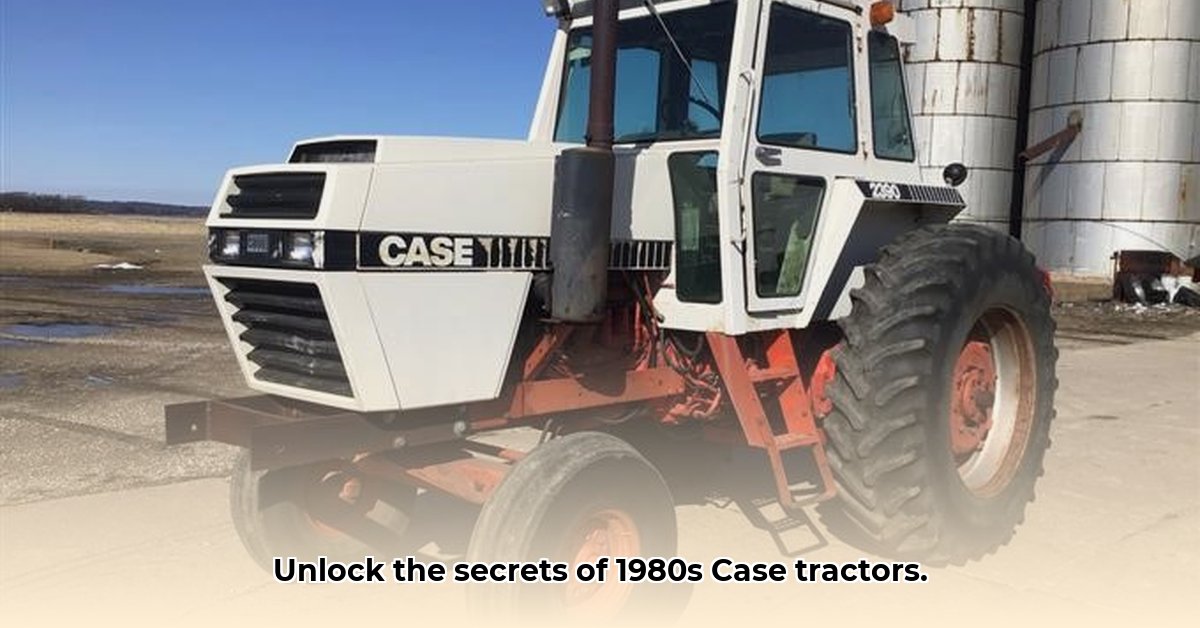
1980s Case Tractors: A Decade of Power and Innovation
The 1980s witnessed a dramatic transformation in agricultural machinery, and Case tractors were at the forefront of this revolution. This era wasn't merely about increased horsepower; it was about technological leaps, strategic mergers, and a diversification of models to meet the evolving needs of farmers. For more detailed specifications on Case IH models, check out this useful resource. This article delves into the fascinating story of Case tractors during this pivotal decade, exploring their key features, technological advancements, and lasting impact on the agricultural landscape.
Key Developments of the 1980s: A Horsepower Arms Race and Beyond
The 1980s saw a significant increase in tractor horsepower. Farmers demanded more power to handle larger fields and increasingly complex machinery. Case responded by developing tractors with substantially enhanced engine capabilities. However, this wasn't just about bigger engines; it was about optimizing engine design for improved fuel efficiency. This led to a competitive "horsepower arms race" amongst manufacturers. But did this increased power always translate to better farming outcomes? While boosting productivity, it also meant higher operating costs and more complex maintenance requirements.
Another defining characteristic of Case's 1980s strategy was model diversification. A "one-size-fits-all" approach was no longer viable. Case recognized the diverse needs of farmers with varying farm sizes and tasks, thus expanding its product line to accommodate these differences. While not every new model became a runaway success, this strategic expansion reflects Case's responsiveness to the evolving needs of the market.
Technological Advancements: Under the Hood of Innovation
Detailed records specifying each technological advancement during this period are scarce. However, the substantial horsepower increases strongly suggest notable improvements in engine technology. It's highly probable that Case also made significant strides in transmission systems (allowing smoother gear changes and increased efficiency), hydraulic systems (for enhanced control and lifting capabilities), and operator controls (increasing ease of use and overall comfort). These improvements transformed the operator experience, shifting from labor-intensive adjustments to more automated systems.
The Case/International Harvester Merger: A Giant is Born
The 1985 merger of Case and International Harvester was a watershed moment, creating Case IH. This momentous event dramatically reshaped the agricultural equipment industry. The merger brought together substantial resources and expertise, setting the stage for streamlined operations and the development of entirely new tractor lines. However, integrating two strong brands with distinct histories and loyal customer bases presented challenges. The long-term integration process had a profound and complex impact on subsequent tractor production, branding, and market share.
Popular Models of the 1980s: A Gallery of Iconic Machines
The 1980s saw the introduction of several iconic Case and early Case IH tractors. While precise technical specifications for every model are difficult to compile comprehensively, several series stand out as emblematic of the era:
| Model Series | Key Features | Significance |
|---|---|---|
| 90 Series (pre-merger) | Robust, dependable engines, reliable performance; suitable for a wide range of farming operations. | Represents Case's established reputation for durable and efficient tractors. |
| 100 Series (pre-merger) | Increased horsepower and size compared to the 90 Series, showcasing Case's progress toward more powerful machines. | A milestone in Case's push for higher horsepower and larger scale farming. |
| Early Case IH Models (post-1985) | Blend of Case and IH design elements; reflected the ongoing integration of the two companies. | Marked the start of a new era, blending design elements and expertise from both parent brands. |
Legacy and Lasting Impact: Shaping the Future of Farming
The Case tractors of the 1980s left an enduring legacy on the agricultural industry. These machines served as a vital bridge between older designs and the technologically advanced tractors of today. Their robust engine designs and focus on reliability continue to influence modern tractor design. Their success speaks to both the engineering prowess and the responsiveness to the changing needs of the farmers who relied upon them.
Conclusion: A Powerful Era in Agricultural History
The 1980s represent a pivotal chapter in the history of Case tractors. This decade was marked by significant technological advances, strategic mergers, and a marked increase in the diversity of available models. The tractors produced during this era profoundly impacted both the agricultural industry and Case IH's subsequent trajectory. The legacy of these powerful machines continues to resonate in modern farming techniques and practices. Further research into specific model variations and their regional impact would undoubtedly reveal even richer details of this fascinating period.